How to make a hydrogen generator for your home with your own hands: practical tips for manufacturing and installation
We are accustomed to considering natural gas to be the most affordable type of fuel.But it turns out that it has a worthy alternative - hydrogen obtained by splitting water. We receive the starting material for the production of this fuel completely free of charge. And if you make a hydrogen generator yourself, the savings will be simply amazing. Right?
We are ready to share with you valuable information about the options and rules for assembling a technical installation intended for the production of hydrogen. Studying the article presented to your attention will guarantee the manufacture of a trouble-free device.
For those wishing to build a cheap but very productive fuel generator with their own hands, we offer detailed instructions. We provide recommendations for proper use. Photo applications and videos were used as informative additions that clearly explain the principle of operation.
The content of the article:
Methods for producing hydrogen
In high school chemistry classes, explanations were once given on how to obtain hydrogen from ordinary tap water. There is such a concept in the chemical field - electrolysis. It is thanks to electrolysis that it is possible to produce hydrogen.
The simplest hydrogen installation is a container filled with water. Two plate electrodes are placed under the water layer. Electric current is supplied to them. Since water is an excellent conductor of electric current, contact with low resistance is established between the plates.
The current passing through the low water resistance promotes the formation of a chemical reaction, which results in the formation of hydrogen.

It would seem that everything is simple and there is very little left to do - collect the resulting hydrogen to use it as an energy source. But chemistry is never complete without subtle details.
So it is here: if hydrogen combines with oxygen, at a certain concentration an explosive mixture is formed. This point is one of the critical phenomena that limits the ability to build sufficiently powerful home stations.
Hydrogen generator design
To build hydrogen generators with your own hands, they usually take Brown’s classic installation scheme as a basis. This medium-power electrolyser consists of a group of cells, each of which contains a group of plate electrodes. The power of the installation is determined by the total surface area of the plate electrodes.
The cells are placed inside a container well isolated from the external environment. The tank body has pipes for connecting the water main, hydrogen outlet, as well as a contact panel for connecting electricity.

The Brown generator circuit, among other things, provides for the presence of a water seal and a check valve.Due to these elements, the installation is protected from hydrogen backflow. According to this scheme, it is theoretically possible to assemble a hydrogen installation, for example, to organize heating of a country house.
Hydrogen heating in the house
Assembling a hydrogen generator for efficient heating of a house is an idea that may not be fantastic, but it is clearly extremely unprofitable. In order to obtain the required volume of hydrogen for a home boiler room, you will need not only a powerful electrolysis installation, but also a significant amount of electrical energy.
Compensating for wasted electricity with hydrogen produced at home seems to be an irrational process.
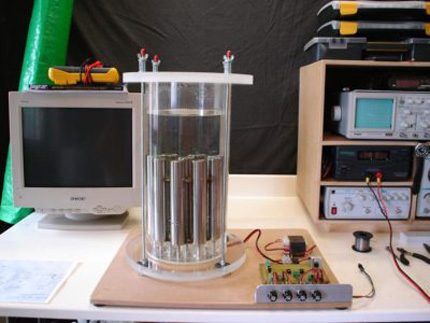
However, attempts to solve the problem of how to make a hydrogen generator for the home with your own hands do not stop. With the operating principle and design of one of the models tested in practice hydrogen boiler will familiarize you with the article, which we recommend that you read.
And here is an example of one of the torture options:
- A sealed, reliable container is prepared.
- Tubular or plate electrodes are made.
- A control circuit for operating voltage and current is assembled.
- Additional modules for the workstation are being made.
- Accessories (hoses, wires, fasteners) are selected.
Naturally, you will need a toolkit, including special equipment such as an oscilloscope and a frequency counter. Having equipped yourself with everything you need, you can proceed directly to the manufacture of a hydrogen heating system for your home.
Do-it-yourself project implementation
Initially, you will need to make a hydrogen generation cell. The fuel cell has overall dimensions slightly smaller than the internal dimensions of the length and width of the generator housing. In height, the size of the block with electrodes is 2/3 of the height of the main body.
The cell can be made of PCB or plexiglass (wall thickness 5-7 mm). To do this, five textolite plates are cut to size. A rectangle is glued together (with epoxy glue), the lower part of which remains open.
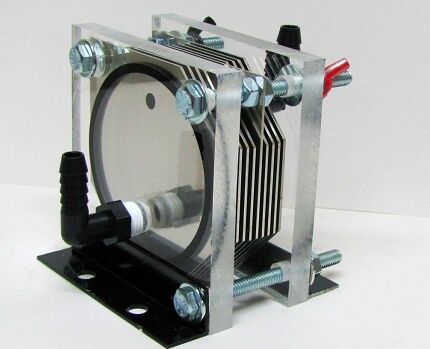
On the upper side of the rectangle, the required number of small holes are drilled for the shanks of the electrode plates, one small hole for the level sensor, plus one hole with a diameter of 10-15 mm for the release of hydrogen.
Electrode plates are placed inside the rectangle, the contact shanks of which are brought out through the holes of the upper plate outside the cell. The water level sensor is installed at 80% cell filling. All transitions in the textolite plate (except for the hydrogen outlet) are filled with epoxy glue.
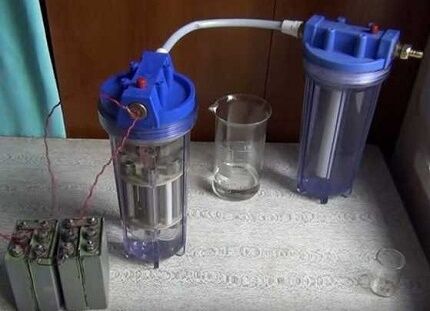
The hydrogen outlet hole must be equipped with a fitting - secure it mechanically using a seal or glue it in. The assembled hydrogen generation cell is placed inside the main body of the device and is carefully sealed along the upper perimeter (again, epoxy resin can be used).
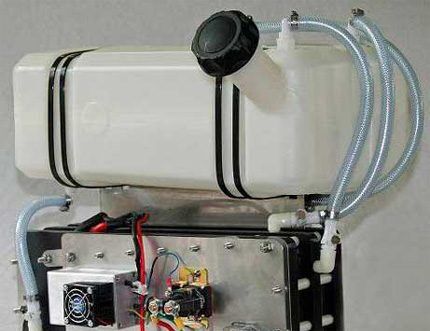
But before you put the cell inside, the generator housing needs to be prepared:
- make a water supply in the bottom area;
- make the top cover with fasteners;
- choose a reliable sealing material;
- place the electrical terminal block on the cover;
- place a hydrogen collector on the lid.
The result should be a partially ready hydrogen generator after:
- The fuel cell is loaded into the housing.
- The electrodes are connected to the terminal block of the cover.
- The hydrogen outlet fitting is connected to the hydrogen manifold.
- The cover is installed on the body through a seal and secured.
All that remains is to connect the water and additional modules.
Hydrogen Generator Supplements
A homemade device for producing hydrogen must be supplemented with auxiliary modules. For example, a water supply module, which is functionally combined with a level sensor installed inside the generator.
In its simplest form, such a module is represented by a water pump and a control controller. The pump is controlled by the controller based on a sensor signal, depending on the water level inside the fuel cell.
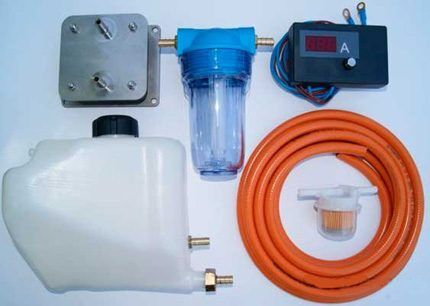
As such, it is also desirable to have a device that regulates the frequency of the electrical current and the voltage level supplied to the terminals of the working electrodes of the fuel cell.At a minimum, the electrical module must be equipped with a voltage stabilizer and overcurrent protection.
A hydrogen manifold, in its simplest form, looks like a tube containing a valve, pressure gauge, check valve. Hydrogen is taken from the collector through a check valve and can actually be supplied to the consumer.

But in practice everything is somewhat more complicated. Hydrogen is an explosive gas with a high combustion temperature. Therefore, simply pumping hydrogen into the heating boiler system as fuel will not work.
Installation quality criteria
It is extremely difficult to assemble a high-quality, efficient and productive installation at home. For example, even if we take into account such a criterion as the metal from which the electrode plates or tubes are made, there is already a risk of encountering problems.
The durability of electrodes depends on the type of metal and its properties. You can, of course, use the same stainless steel, but the lifespan of such elements will be short.
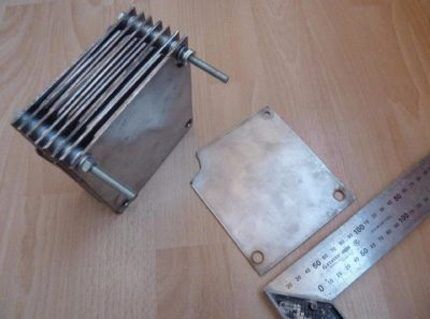
Installation dimensions also play a significant role. Calculations with high accuracy are required in relation to the required power, water quality and other parameters.
So, if the gap between the working electrodes is outside the calculated value, the hydrogen generator may not function at all. In the worst case, the power for which the calculation was made will turn out to be several times less.
Even the cross-section of the wire connecting the electrodes to the power source is important in the design of a hydrogen generator. True, this concerns the safe operation of the device. However, this design detail should also be taken into account in home installations.
Returning to the safe operation of the system, one should also not forget about the introduction of a so-called water seal into the design, which prevents the reverse movement of gas.
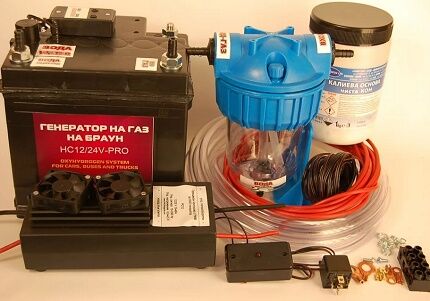
Industrial generator
At the level of industrial production, technologies for manufacturing hydrogen generators for household use are gradually being mastered and developed. As a rule, energy stations for home use are produced, the power of which does not exceed 1 kW.
Such a device is designed to produce hydrogen fuel in continuous operation for no more than 8 hours. Their main purpose is energy supply for heating systems.
Installations for operation within condominiums are also developed and manufactured. These are already more powerful designs (5-7 kW), the purpose of which is not only the energy of heating systems, but also the generation of electricity. This combination option is quickly gaining popularity in Western countries and Japan.
Combined hydrogen generators are characterized as systems with high efficiency and low carbon dioxide emissions.

Russian industry has also begun to engage in this promising type of fuel production. In particular, Norilsk Nickel is mastering technologies for the production of hydrogen installations, including household ones.
It is planned to use a variety of fuel cell types during development and production:
- proton exchange membrane;
- orthophosphoric acid;
- proton exchange methanol;
- alkaline;
- solid oxide.
Meanwhile, the electrolysis process is reversible. This fact suggests that it is possible to obtain already heated water without burning hydrogen.
It seems that this is just another idea that, if you grab onto it, you can launch a new round of passions related to the free production of fuel for your home boiler.
Conclusions and useful video on the topic
When experimenting at home with homemade models, you need to prepare for the most unexpected results, but negative experience is also experience:
DIY hydrogen generators for the home are still a project that exists at the level of one idea. There are no practically implemented do-it-yourself hydrogen generator projects, and those that are positioned online are the imagination of their authors or purely theoretical options.
So we can only rely on an expensive industrial product that promises to appear in the near future.
Do you know the original model of a hydrogen generator that is not described in the article? Maybe you want to share valuable information that will be useful for home craftsmen? Please write comments in the block below, post photos on the topic, express your opinion.




This method of producing hydrogen fuel by electrolysis of water will be too energy intensive. I can assure you that methods have long been invented to produce light, inexpensive and environmentally friendly fuel, for example, hydrogen. But this is not beneficial for some. Tesla electric cars show a little hope, and many are already switching from internal combustion engines to electric ones. This is definitely a step in the right direction.
For those who read the article and are interested. Since 1981, this topic has not left the pages of magazines, newspapers and the Internet. Numerous “authors” publish “their” works, incl. on YouTube, but I have never seen a complete analysis of such an installation anywhere.
Namely:
1. The electrolysis process is based on Faraday’s law (25 Amperes) - I have not seen power balance calculations anywhere.
2. I have not seen cooling devices (especially a water seal) in any published installation.
3. I have never seen devices for releasing excess pressure of the gas mixture of an electrolysis installation.
We could go on, but this is enough to make the obvious conclusion - none of these “authors” have ever used such a device in practice. Just as an experiment.
When current is applied to the plates (let me remind you, according to Faraday, up to 25A), they naturally heat up. According to theory, heating above 60°C is highly undesirable. The higher the current, the greater the heating.How many seconds will such a device operate without cooling? Especially if it is made of plexiglass... As a result of the electrolysis of water, steam is released, which, passing through a water seal, undergoes “cleaning” and the output is an exact ratio of 2/1 hydrogen and oxygen. I repeat - where is the cooling? What is shown in numerous videos can be called a demonstration model, nothing more. What they are trying to “foist” from enterprises is, at best, a deception of the consumer based on greed.
I completely agree with Gennady and Sergey! The law of conservation of energy has not yet been canceled! And if we assume that the efficiency of the electrolyzer installation will be 100% (in terms of thermal energy, which in principle cannot be), then the amount of electricity consumed will be equal to the energy (heat) released during the combustion of hydrogen.
Well, those freaks who are pushing all these stupid ideas definitely didn’t study elementary physics at school! From myself I can say that in an electrolyzer installation it makes sense only in the form of a high-temperature torch/cutter/welding, when acetylene/simple gas-oxygen/electric, etc. and so on. for some reason not desirable or unavailable. Dot.
Igor, I would like to know what truth you taught at school? Are you aware that firewood, coal, gasoline, and gas are not energy sources and do not burn? You learned in school that water boils at 100 degrees, right? And what moron said this? Does water not evaporate at 0 degrees? Maybe the kettle flame is 100 degrees. Don't think that everyone is as retarded as you! By the way, hydroelectric power plants are an alternative source of energy...
I have no words! What kind of frein did you use (lysergic acid diethylamide, or simple plaster) before writing about the “kettle flame”??? Cool! I will share with friends! - No-o-o, of course I don’t know that the water is boiling at different degrees in storage in the form of a thousand - the current degrees are not Fahrenheit, but those that are 40 according to Mendeleev!!! Re-read your own message, Vladimir! Dot.
I completely agree - Colleague! I’m just amazed at what our society is like! - They write such articles, design websites and mislead fragile minds! As it is written in a chemistry textbook, during the oxidation of hydrogen (explosion or combustion), the same amount of energy is released as was spent on electrolysis minus losses! What's the point of heating a stove with hydrogen if it can be done with electricity and even without the aforementioned losses! - After all, we are talking about home heating, which means home power supply is also implied!
Igor, you are too radical in your statements, you can be called a super-skeptic)) Look more broadly. Hydrogen is an alternative energy source, not just a gas burner. There are also hydrogen baths, hydrogen water for consumption, hydrogen inhalation and probably much more where efficiency does not matter! The very possibility of producing hydrogen at home, even with the help of electricity, is already very cool for any kind of experimenters. Don't forget that we also have solar energy and electricity in the atmosphere - both are free for now and may help us get more hydrogen.
Hello. You seem to have built a quite strong logical chain and even mentioned the school physics curriculum.That is, in your opinion, a hydrogen generator cannot produce more energy than is supplied to it. By the same logic, it turns out that nuclear power plants do not produce more energy than they consume. But everyone knows that this is not so, even those who are not particularly familiar with physics.
I'm not suggesting that a hydrogen generator is a great solution for industry or the private sector. But there is no need to categorically write him off. As for practical experiments, there are craftsman.
His electrolyzer has been running for about six months, but there is an urgent problem - the formation of foam. By the way, this video shows how to use the device as a burner. This is truly the best option. Much more practical than implementing hydrogen heating. And safer, of course!
In this case, do not use LED lamps for lighting, but an Ilyich light bulb.
Your phrase, Amir: “You seem to have built a quite strong logical chain and even mentioned the school physics curriculum. That is, in your opinion, a hydrogen generator cannot produce more energy than is supplied to it”...
YES!!! This is exactly what I am saying! Otherwise, why have you, Amir, and others like you still not built a Perpetual Motion Machine, or simply an engine with an efficiency of more than 100%?
As for what kind of physics I studied at school, I answer Vladimir - ELEMENTARY, not nuclear. With nuclear everything is more complicated and interesting, but it’s not suitable for home experiments. Well, there are no (at least not yet) portable (pocket) thermonuclear reactors that can extract the difference in bond energies between the simplest hydrogen atoms: deuterium and tritium!
Well, as for the so-called.some “folk craftsmen”, I declare with full responsibility: there is simply a hidden, excuse me, “tattoo” for the gullible - additional energy is used in demonstrations!!! IMHO!
Thank you for the information.
A lot of interesting.
I am not a scientist, 3rd grade parochial school.
Question to the authors.
Why do you know your installation with hydrogen?
Or what kind of acid is running from your tap that steel is consumed to zero in 8 hours?
Yes, we have chemistry, we conduct experiments on it.
But all our electrodes are intact, and Brown’s too.
Norilsk Nickel and the Japanese also do not offer to use steel.
And you produced hydrogen, but aluminum and steel burned.
Perhaps you are connecting something unnecessary?
Or do you simply forget to pour water and simply burn the electrodes with an electric arc?
So this is a welding machine.
In general, thank you again for the information.
A few stupid questions -
1. During the electrolysis of water, not only hydrogen is produced, but also oxygen?
2. To obtain such an amount of hydrogen that, upon combustion, will produce 1 kW hour of energy, isn’t it necessary to spend 1 kW hour or a little more electricity?
3. Why then get hydrogen? Isn’t it easier to use the same electricity to heat a boiler for heating a house?
4. And if I’m wrong, does the author claim to have invented a perpetual motion machine?
Why doesn't anyone think about car engines, simple ones. Instead of gasoline, hydrogen. Electricity will be more than generated for both hydrogen expansion and additional consumption. If desired, several generators can be connected to the engine. But one 24V 100 ampere should more than meet all needs.And all sorts of cut-offs and adjustment devices can be equipped with the installation without difficulty. 10% per idea
About 40 years ago I saw this installation in operation as a gas burner. And the description was published in the magazine “Modelist Constructor”